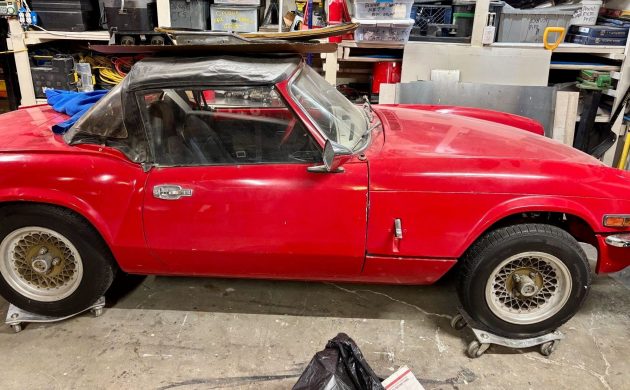- Seller: James R (Contact)
- Location: Reno, Nevada
- Mileage: 80,000 Shown
- Chassis #: FK25529L
- Title Status: Clean
- Engine: 1300 Inline-4
- Transmission: 4-Speed Manual
There used to be a time when Triumph Spitfires were just about everywhere. These small sports cars were an outstanding balance of affordability and fun. This formula worked out great for Triumph, and they ended up building over 300k of them between 1962 and 1980. While not many cars by American manufacturers’ standards, that’s pretty impressive for a British Sports car that lacks a rear seat! This 1972 example is a Mark IV project the seller found in a storage container at a family member’s Gerlack, Nevada home. It already had some of the heavy lifting done, but it needs someone to finish it. If that person is you, it’s now located in Reno, Nevada, with a $3,500 asking price!
The Mark IV Spitfire was produced from 1970 until 1974. While it retained the 1,296cc 4-cylinder engine that debuted in the Mark III, the front and rear of the car were both restyled, and the rear suspension was improved. Early Spitfires were known to have some issues with their swing-axle rear suspension, so Triumph revised the design for the Mark IV, which fixed the worst of the swing-axle’s flaws and made the already fun handling Spitfire that much better to drive.
Someone started restoring this Spitfire, but there’s still a lot of work to be done. Inside, it looks like it will, at the very least, need new seat upholstery, dash cap, and some other soft bits, but parts are readily available for these. The seller notes that there’s some rust in the floor pans that needs to be addressed. Hopefully, it’s a minor issue. These are straightforward little cars and are a popular option for those wanting to learn how to restore a vehicle. If the floors aren’t too rough, this one could be a great place to start.
The seller states that the engine has already been rebuilt. They provided photos of it out of the car, before reinstalling it. Besides rebuilding the engine, they installed a new clutch and fuel pump. The 1,296 is a good engine and offered better performance than the 1500 fitted in later Spitfires. The seller notes that the engine has yet to be fired, so there will be some prep needed to fire it and break it in, but that’s all pretty minor. Having a fresh engine with new gaskets/seals is a huge plus!
This could be a fun and affordable project. These Mark IV are super fun to drive. You don’t find them quite as often as the later 1500s, which makes it a bit more interesting in our book. So, if you’d love to take a closer look at it, be sure to message the seller!

















I see lots of parts but not much of a complete car. Maybe roll it outside and take a few shots to show the buyer what it looks like?
Triumphs of all versions were slightly more upscale than their competition from MG, as the MG equivalents to their Triumph counterparts all featured a solid (live) axle in back. The MG Midget was the direct competitor to the Spitfire, and the MGB was a direct competitor to the TR6, but the MGB, in addition to the solid rear axle made do with a four-cylinder engine, while the TR6 got a six-cylinder power plant. I tend to prefer the TR6, for the six-cylinder mill and the fully-independent rear suspension, while the Spitfire made do with swing axles, omitting the second universal joint in each half shaft. The aftermarket has seen fit to offer replacement half-shafts for the TR6 that replace the cruciform U-Joints will CV joints, for smoother operation and reduced noise.
See the link to Triumph TR-6 aftermarket parts here:
https://www.goodparts.com/
No mention of if the Spitfire has unibody construction or a full frame like its big brother, the TR-6.
Spits have an X frame.
Thank you for letting me know! I always like to learn something new about cars!